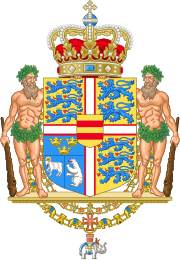1918 Danish Folketing election
| |||||||||||||||||||||||||||||||||||||||||
All 140 seats in the Folketing 71 seats needed for a majority | |||||||||||||||||||||||||||||||||||||||||
This lists parties that won seats. See the complete results below.
| |||||||||||||||||||||||||||||||||||||||||
 |
|---|
Folketing elections were held in Denmark on 22 April 1918,[1] the first in which women could vote. The result was a victory for Venstre, which won 45 of the 140 seats in the Folketing, which had been expanded from 114 to 140 seats. Voter turnout was 75.5%.[2]
Electoral system[edit]
The Folketing was elected by rural–urban proportional representation. Copenhagen had 24 members elected by party-list proportional representation using the d'Hondt system, while in the rest of the country 93 members (42 in the Danish Islands and 51 in Jutland) were elected in single-member constituencies using first-past-the-post voting. There were a further 23 leveling seats to make the results more proportional.[3]
Of the 23 leveling seats, twenty (nine in the islands and eleven in Jutland) were allocated on a regional basis, and three (one in the islands and two in Jutland) were allocated based on the nationwide vote (including Copenhagen).[3] The allocation of candidates to leveling seats was based on a best-loser rule, using a form of Scorporo; in each single-member constituency a Hare quota of votes for the appropriate region was subtracted from the winner's votes and the remainders were pooled at a county level. The candidates with the highest proportion of the votes relative to the region's Hare quota were allocated the leveling seats.[3]
The 1918 elections were the only ones in Danish history to feature this mixed system.[4][5] Future elections would be entirely using proportional representation with the single-member districts not affecting the party-level results.
Results[edit]
 | |||||
|---|---|---|---|---|---|
| Party | Votes | % | Seats | +/– | |
| Venstre | 269,646 | 29.41 | 45 | +2 | |
| Social Democratic Party | 262,796 | 28.66 | 39 | +7 | |
| Danish Social Liberal Party | 189,521 | 20.67 | 32 | +1 | |
| Conservative People's Party | 167,743 | 18.29 | 22 | New | |
| Industry List | 11,934 | 1.30 | 1 | New | |
| New Right | 4,764 | 0.52 | 0 | New | |
| Voters of 1918 | 4,407 | 0.48 | 0 | New | |
| Socialist Workers Party | 1,410 | 0.15 | 0 | New | |
| Independent Social Democracy | 1,086 | 0.12 | 0 | New | |
| Independents | 3,622 | 0.40 | 1 | 0 | |
| Total | 916,929 | 100.00 | 140 | +26 | |
| Valid votes | 916,929 | 99.62 | |||
| Invalid/blank votes | 3,468 | 0.38 | |||
| Total votes | 920,397 | 100.00 | |||
| Registered voters/turnout | 1,218,901 | 75.51 | |||
| Source: Nohlen & Stöver | |||||
References[edit]
- ^ Dieter Nohlen & Philip Stöver (2010) Elections in Europe: A data handbook, p524 ISBN 978-3-8329-5609-7
- ^ Nohlen & Stöver, p537
- ^ a b c Saby, R. S. (1919). "Danish Parliamentary Elections of 1918". American Political Science Review. 13 (4): 656–662. doi:10.2307/1944222. ISSN 0003-0554. JSTOR 1944222.
- ^ The Parliamentary Electoral System in Denmark Archived 2022-01-21 at the Wayback Machine Folketing
- ^ Adolph, Jensen (July 1918). "Rigsdagsvalgene i April-Maj 1918 med Suppleringsvalg i Tiden 1915-18". Danmarks Statistik.

